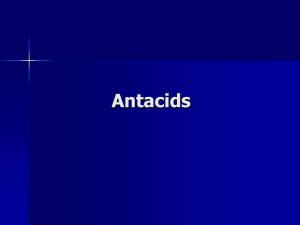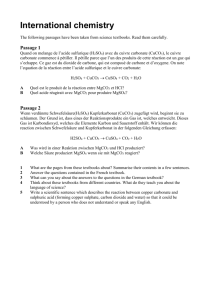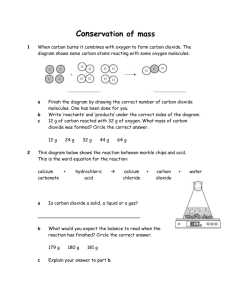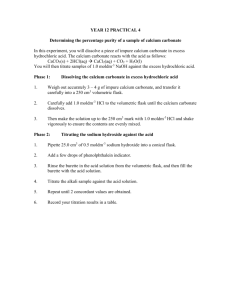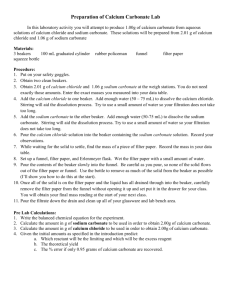File - Ruawai College Science
advertisement
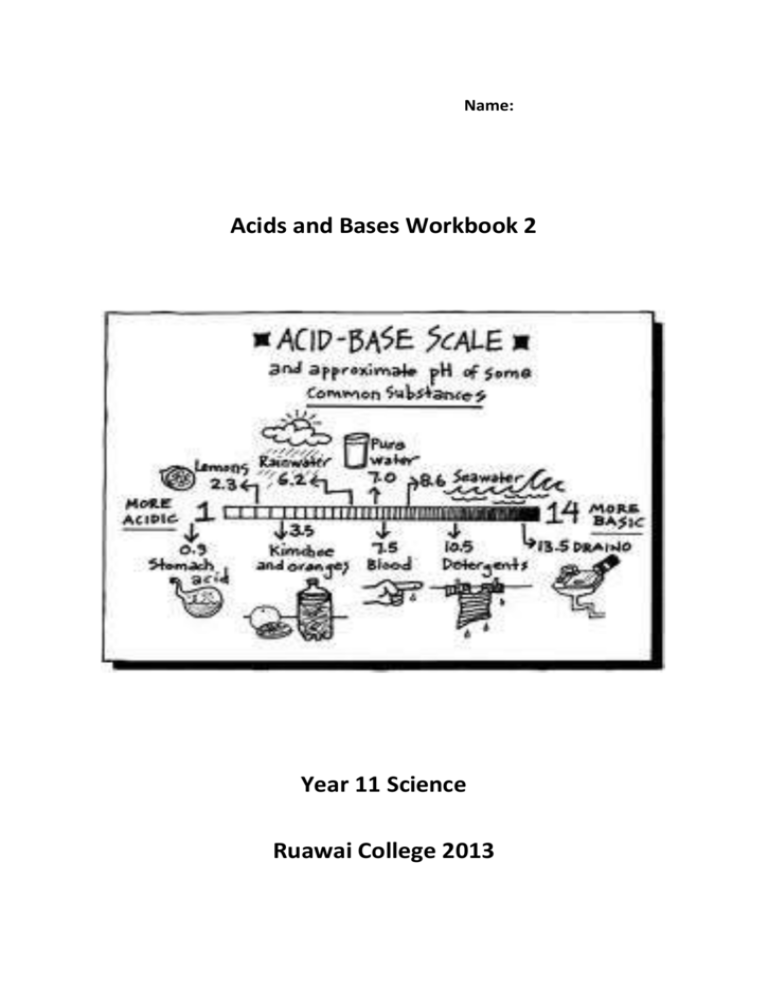
Name: Acids and Bases Workbook 2 Year 11 Science Ruawai College 2013 Metal hydroxides: are bases contain OH- Metal Oxides: are bases some react with water to form hydroxides Calcium hydroxide forms when calcium oxide is added to water. CaO + H2O Ca(OH)2 1. Is calcium hydroxide a base? 2. Give a reason for your answer to #1. base Contains hydroxide ion, OH3. Is calcium oxide a base? base 4. Give a reason for your answer to #3. Forms hydroxide when added to water Metal hydroxides and metal oxides have the same chemical properties. magnesium hydroxide Mg(OH)2 + + hydrochloric acid water + magnesium chloride 2HCl 2H2O + MgCl2 In the reaction above: 5. What is the name and formula of the acid? Hydrochloric acid, HCl 6. What is the name and formula of the base? Magnesium hydroxide, Mg(OH)2 7. What is the name and formula of the salt formed? Magnesium chloride, MgCl2 8. What is the name and formula of the other product formed? Water, H2O magnesium oxide MgO + + hydrochloric acid water + magnesium chloride 2HCl H2O + MgCl2 In the reaction above: 9. What is the name and formula of the acid? Hydrochloric acid, HCl 10. What is the name and formula of the base? Magnesium oxide, MgO 11. What is the name and formula of the salt formed? Magnesium chloride, MgCl2 12. What is the name and formula of the other product formed? Water, H2O 13. Write a general word equation for the reaction of an acid and a metal oxide. metal oxide + acid metal salt + water 14. Write a general word equation for the reaction an acid and a metal hydroxide. metal hydroxide + acid metal salt + water Metal carbonates: are bases form a salt, water and carbon dioxide when they react with acids Metal hydrogen carbonates: are bases form a salt, water and carbon dioxide when they react with acids copper + carbonate sulfuric acid water + carbon dioxide + copper sulfate CuCO3 H2SO4 H2O CO2 + CuSO4 + In the reaction above: 15. What is the name and formula of the acid? Sulfuric acid, H2SO4 + 16. What is the name and formula of the carbonate? copper carbonate, CuCO3 17. What is the name and formula of the salt formed? Copper sulfate, CuSO4 18. What is the name and formulae of the other products formed? Water, H2O and carbon dioxide, CO2 lithium + hydrogen carbonate hydrochloric acid water + carbon dioxide + lithium chloride LiHCO3 HCl H2O CO2 + LiCl + + In the reaction above: 19. What is the name and formula of the acid? Hydrochloric acid, HCl 20. What is the name and formula of the carbonate? Lithium hydrogen carbonate, LiHCO3 21. What is the name and formula of the salt formed? Lithium chloride, LiCl 22. What is the name and formulae of the other products formed? Water, H2O and carbon dioxide, CO2 23. Write the general word equation for the reaction of an acid and a carbonate. carbonate + acid water + carbon dioxide + salt 24. Write the general word equation for the reaction of an acid and a hydrogen carbonate. hydrogen carbonate + acid water + carbon dioxide + salt Acid-Carbonate reactions in everyday life: The acid-carbonate reaction is useful for: its neutralising effect the production of CO2 Cells in the wall of the stomach produce hydrochloric acid, HCl, to help digest food. If excess acid is produced, pain can result – this is heartburn. Swallowing an antacid tablet can neutralise the acid. Antacid tablets contain calcium carbonate, CaCO3, and magnesium carbonate, MgCO3. 25. HCl + CaCO3 CaCl2 + H2O + CO2 HCl + MgCO3 MgCl2 + H2O + CO2 What is the name and the formula of the acid produced in the stomach to help digest food? Hydrochloric acid, HCl 26. What happens when too much of this acid is produced? You get heartburn 27. What kind of tablet can be taken to stop the pain caused by too much acid in the stomach? antacid 28. What two chemicals do antacid tablets contain? calcium carbonate, CaCO3, and magnesium carbonate, MgCO3. 29. What is the formula of calcium carbonate? CaCO3 30. What is formed when calcium carbonate reacts with hydrochloric acid? Calcium chloride, water and carbon dioxide 31. What is the formula of magnesium carbonate? MgCO3. 32. What is formed when magnesium carbonate reacts with hydrochloric acid? magnesium chloride, water and carbon dioxide Raising agents such as baking soda create bubbles of carbon dioxide gas in flour mixtures, making the baking ‘rise’. Baking soda is sodium hydrogen carbonate, NaHCO3. When it contacts a weak acid, such as acid in milk, honey, cocoa or fruit, it gives off CO2. carbonate 33. + acid salt + water + carbon dioxide What is a raising agent? Substance that makes baking rise 34. What is the formula of sodium hydrogen carbonate? NaHCO3. 35. What is produced when sodium hydrogen carbonate reacts with a weak acid? Salt, water and carbon dioxide 36. Why is sodium hydrogen carbonate used in baking? Carbon dioxide produced makes baking rise Geologists carry a small dropper of dilute HCl when they are doing fieldwork. If a rock fizzes when acid is dropped on it, the rock contains a carbonate (e.g. limestone is calcium carbonate, CaCO3. carbonate 37. + acid salt + water + carbon dioxide Why would a rock fizz if acid was put on it? Contains a carbonate and produces carbon dioxide when reacts with acid A home-made fizzy drink can be made by mixing a little baking soda with citric acid and adding water. sodium hydrogen carbonate + acid salt + water + carbon dioxide Try this at home. 38. Write the general word equation for the reaction of an acid and a carbonate. carbonate 39. + acid salt + water + carbon dioxide Describe a test for carbon dioxide gas. Turns limewater cloudy 40. Complete each of the following word equations for the reaction between an acid and a carbonate by filling in the missing word and then writing a balanced symbol equation for each reaction. a. nitric + acid HNO3 + sodium carbonate Na2CO3 sodium + carbon dioxide + water nitrate Na2NO3 + CO2 + H2O hydrochloric + calcium carbonate calcium chloride + carbon dioxide + water acid b. 2HCl + CaCO3 CaCl2 + CO2 + sulfuric + calcium carbonate calcium sulfate + carbon dioxide acid c. H 2SO4 + CaCO3 CaSO4 + CO2 + H2O + water H2O 41. A homemade remedy for indigestion caused by excess stomach acid is to drink a little baking soda (sodium hydrogen carbonate) in water. a. Write a word equation for the reaction that occurs. Hydrochloric acid + sodium hydrogen carbonate sodium chloride + water + carbon dioxide b. Write a balanced symbol equation for the reaction. HCl + NaHCO3 NaCl + H2O + CO2 42. Formic acid, found in bee stings, formed salts called formates. Name the salt formed when a bee sting is neutralised with baking soda (sodium hydrogen carbonate). Sodium formate 43. A white metal compound ‘fizzes’ when some dilute hydrochloric acid is added to it. Describe what sort of substance the white material is likely to be, and give a reason for your answer. Carbonate 44. Describe how you could prepare some white crystals of magnesium chloride, starting with hydrochloric acid and a (white-coloured) carbonate. In your answer, include the following: which carbonate you would use what you would do what you would see how you would make sure all the hydrochloric acid was neutralised Hydrochloric acid would need to be neutralised by magnesium carbonate to obtain magnesium chloride. Add excess magnesium carbonate to hydrochloric acid. You would see bubbles of carbon dioxide gas produced. When the bubbling stopped, a drop of Universal Indicator staying green would show that all the acid had been neutralised. Any excess magnesium carbonate could be removed by filtering. The filtrate would be magnesium chloride, which can be heated to evaporate off the water, leaving the magnesium chloride. Exam Question One The student combines equal volumes of nitric acid solution and sodium carbonate solution. Both solutions have the same concentration. Discuss what happens in this reaction. In your answer, you should: name the type of reaction involved and the ions involved describe what the student would observe state the products of the reaction and link these to the observations made write a word equation for the reaction write a balanced symbol equation for the reaction Identification of reaction type: Acid-base (or acid-carbonate) neutralisation (the carbonate ions react with the H+ ions of the acidic solution and neutralise the solution). Description of observations: Bubbling in the solution /fizzing /effervescence /frothing /foaming Ca2CO3 disappears. Linking observations to products: The products are CO2, H2O and a salt. The CO2 gas causes the bubbles /fizzing /etc. Writing a word equation: Nitric acid + sodium carbonate sodium nitrate + water + carbon dioxide Writing a symbol equation: 2HNO3 + Na2CO3 2NaNO3 + H2O + CO2




